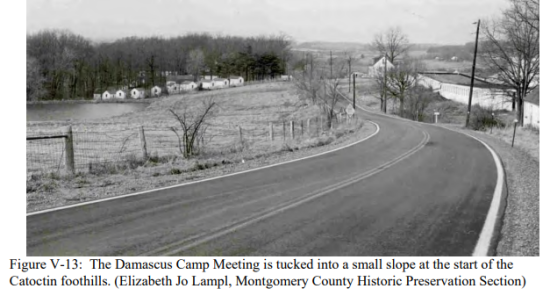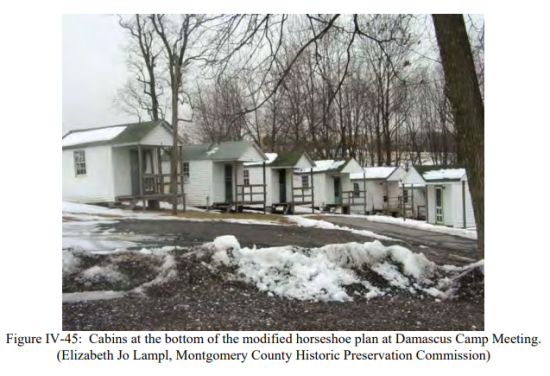Just a few miles up the road from Washington Grove — on Bethesda Church Road, not too far off Route 27 (Ridge Road) — stand the remnants of another camp meeting site, the Damascus Camp Meeting (also known as Beall’s Grove Camp Meeting). As was the case for Washington Grove, a bucolic, wooded setting was chosen for the camp meeting’s establishment. A grove of mature hardwood trees with a view of Sugarloaf Mountain was selected for the Damascus site. Like Washington Grove, the Damascus Camp Meeting was rooted in Methodism (more specifically in The Holiness Association, in the case of the Damascus Camp Meeting, where the interdenominational aspects of the Holiness movement were quickly adopted).
The Maryland Historical Trust (MHT), Maryland Inventory of Historic Properties Form for the Damascus site provides more information about the Holiness Movement — “The Holiness Revival began when Methodists sought to infuse the Wesleyan church with the urgency of God’s holiness, or separateness, and the sense that salvation was a continually necessary process due to the ability of believers to “back slide.” The Holiness movement was one of the largest reasons behind a renewed interest in camp meetings following the Civil War and for the toning down of bodily excesses associated with it.”
However, unlike Washington Grove (and neighboring Emory Grove), the railroad did not play an enabling role in the establishment or growth of the Damascus Camp Meeting; its participants were more likely to arrive at the camp site by automobile. Worshippers were drawn not from the elite of Washington, DC, but rather from the surrounding farms. Established in the early 1930s, it reflected a Depression-era ethic of modest simplicity (no Victorian gingerbread would be found at the Damascus site). The camp was laid out in a horseshoe form, and included an anchoring Tabernacle, boys’ and girls’ dormitories and some forty (mostly) one-room cottages.
The Damascus camp meeting era has ended, but an active year-round congregation, the Difference Makers Church (with Methodist/Wesleyan roots), now worships at the site. If you visit today, you will find a long, low, stone wall at roadside marking the site. The 1935 Tabernacle, the former caretaker’s cottage and a few communal buildings have survived, though some have been substantially modified. At the front of the open-air Tabernacle, where a preacher would stand, hangs what may be an original hand-painted wooden banner that proclaims “Holiness Unto The Lord” (a reminder of the Holiness Association roots).
The 2004 MHT inventory for the site had warned that “like the other Depression-era camp meeting in the county, the property is threatened; in this case, partially because the camp meeting tradition has been dissolved…” Indeed, the tiny cottages, with few exceptions, have been lost.
The evocative photograph below (c. 2004) is reproduced from the Historic Context Report entitled “A Harvest in the Open for Saving Souls”, The Camp Meetings of Montgomery County, prepared by Elizabeth Jo Lampl and Clare Lise Kelly for the Maryland Historical Trust. One can imagine worshipers’ anticipation of spiritual renewal, travelling up Bethesda Church Road, as the huddled, modest cottages were finally presented to view.


A Washington Post article from August 12, 1987, entitled “The Road to Damascus” covers that summer’s camp meeting season and includes the implication that some of the cottages had been air warden cottages from World War II. “[Dr Clayton S. Luce] ran the show for years, hauled World War II air warden cottages from Conowingo Dam in Northern Maryland and an old school bus body from Georgia, which now serves as the campground candy store.” However, further research has not corroborated the origins of the minimally framed, Masonite-sided cottages.
For interesting tidbits about the history of Damascus (which was once considered the heart of a tobacco-growing region, and where tobacco continued to be grown through the beginning of the 20th century) and a deeper dive into the history of the Damascus Camp Meeting, see The Maryland Historical Trust, Maryland Inventory of Historic Properties Form (M:10-21) (PDF).
More information and photographs about the various camp meetings in Montgomery County can be found in the above-referenced historic context report (PDF).
